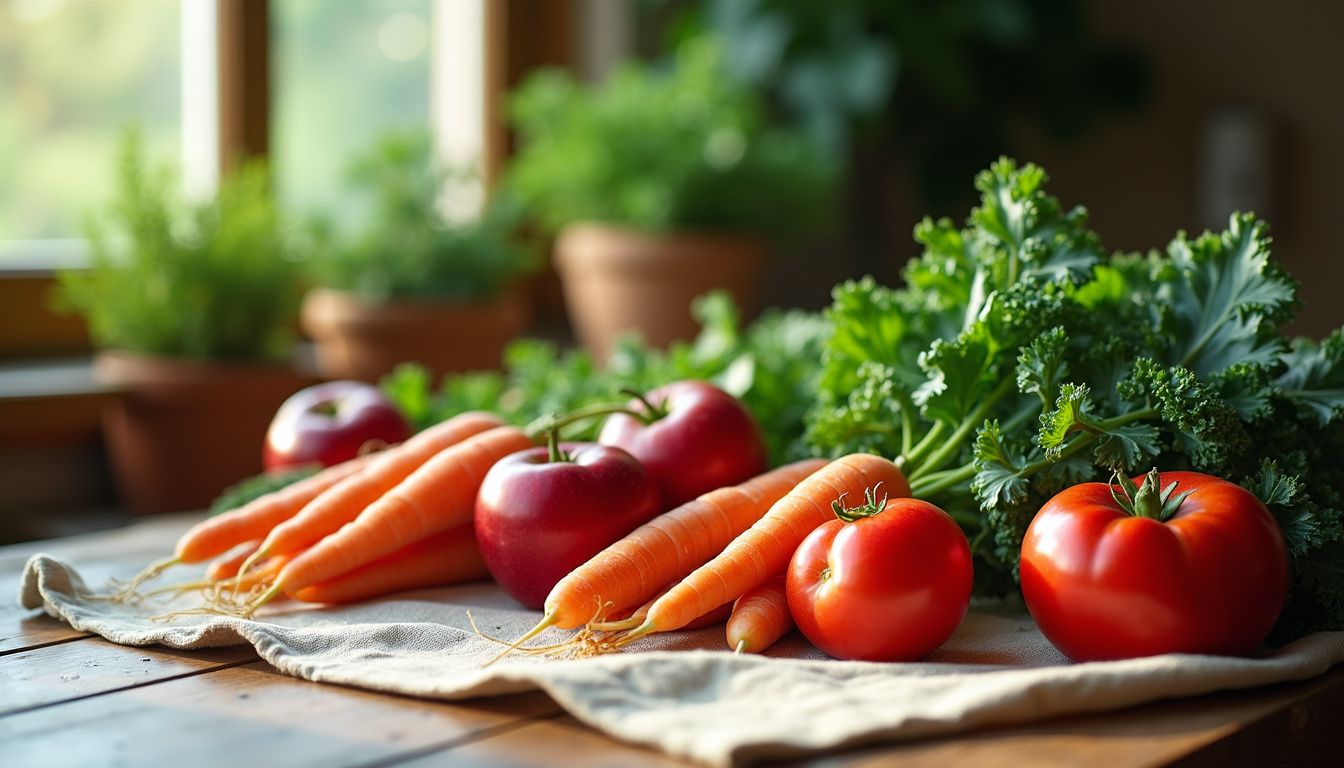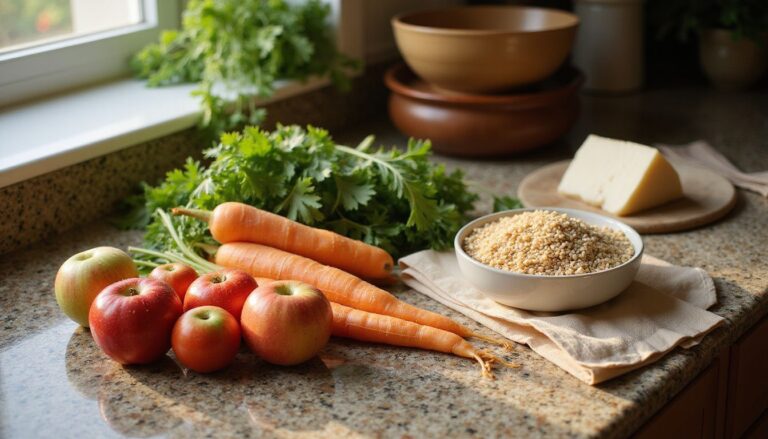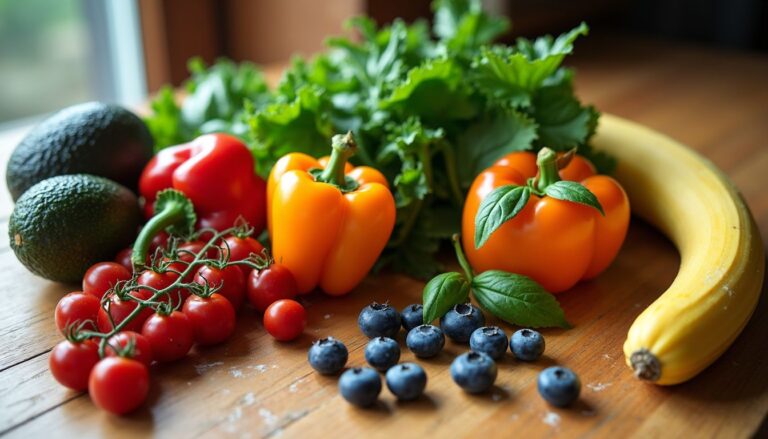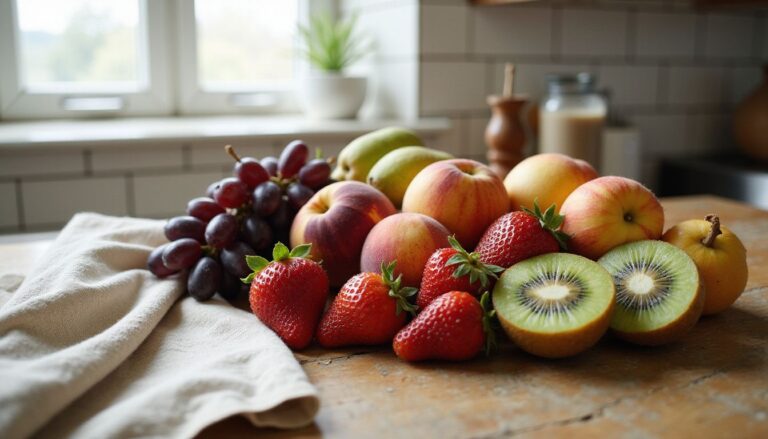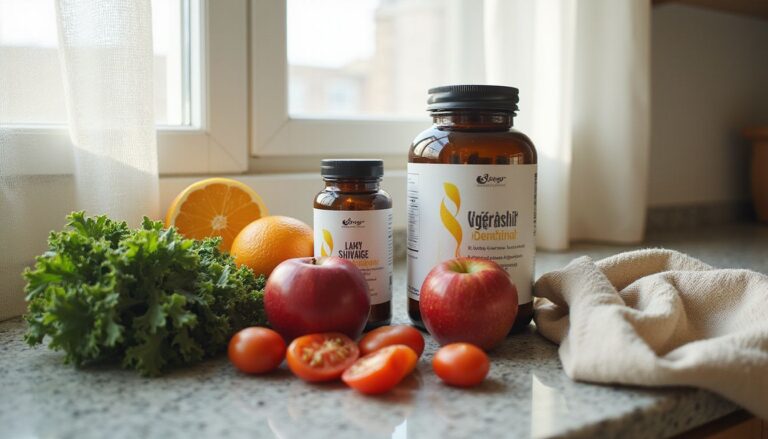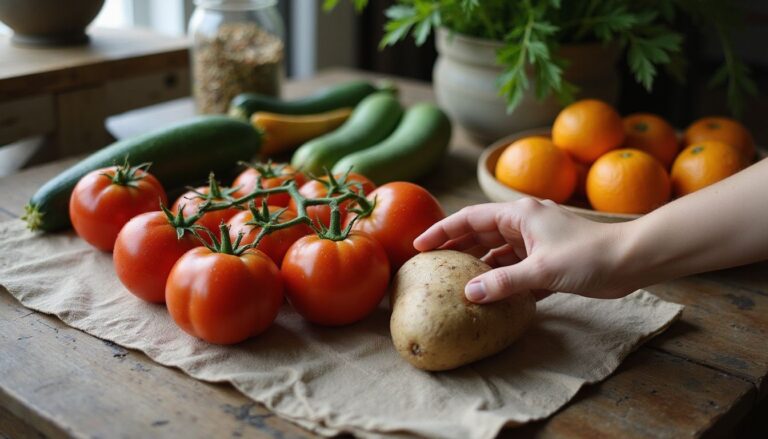Top 7 Foods To Help Lose Weight: Boost Your Healthy Eating With These Calorie-Burning Fruits And Vegetables
Our Nutrition Assistant AI Suite will transform your body. You will lose fat, get toned, and build muscle. Gain confidence and optimal health.
If you are trying to lose weight, food choices can feel confusing. The good news is that many simple foods help you feel full, support healthy eating, and keep calories in check. Most winners are high in fiber, low in calories, and rich in vitamins and minerals.
This guide highlights seven foods that may help you lose weight. You will also see how certain fruits and vegetables make it easier to stick with a healthy eating plan. Use these ideas to build meals that work in real life, even on busy days.
Keep reading to learn easy ways these options can fit your routine and support steady progress.
Key Takeaways
- High protein choices, such as eggs and skinless chicken breast, curb hunger. A 100 gram serving of chicken breast offers about 31 grams of protein and only 3.6 grams of fat (American Heart Association).
- Eating more fruits and vegetables increases fullness for fewer calories. Ten cups of spinach with 1.5 cups of strawberries and a small apple is roughly 250 calories.
- Whole grains, including oats, quinoa, and brown rice, support weight management better than refined grains (Roager HM et al., 2019).
- Healthy fats from avocados and nuts keep you satisfied. A medium avocado has about 13 grams of fiber, but portions matter because calories add up quickly.
- Planning meals with nutrient-dense foods reduces impulsive eating and supports lasting weight loss (Am J Prev Med 2017;52(5):736-742).
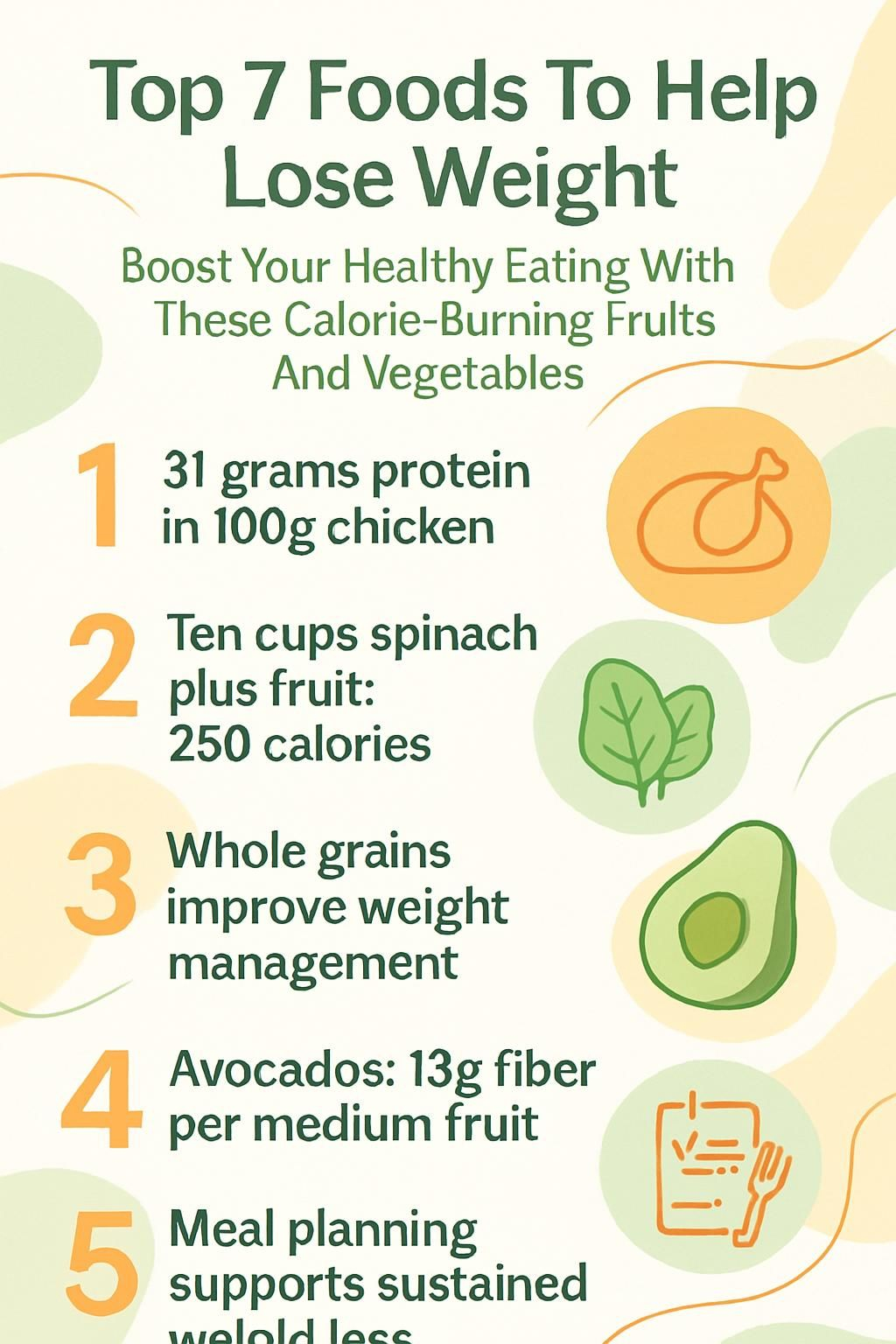
Why Are Food Choices Crucial for Weight Loss?
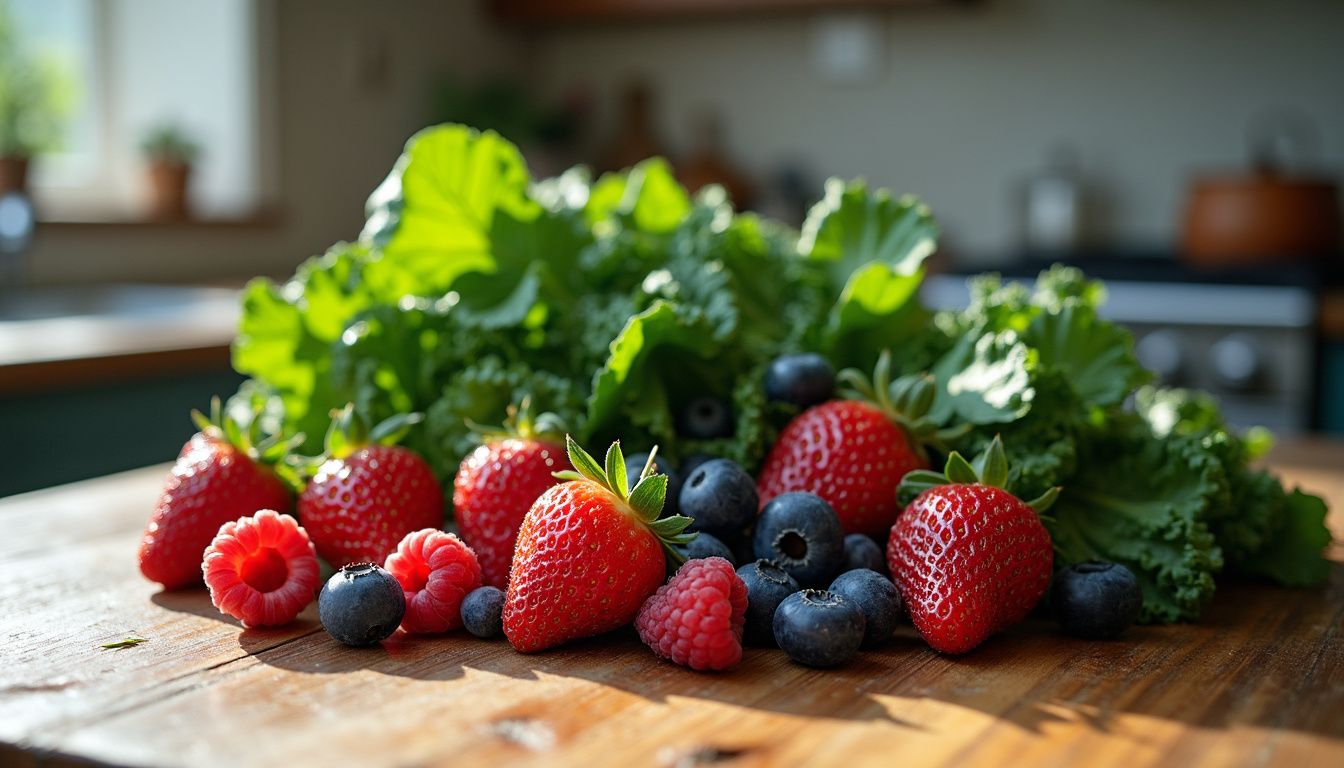
Your daily food choices shape calorie intake and how long you feel full. Focusing on low-energy-dense foods, like fruits and vegetables, lets you eat more volume while taking in fewer calories than your body uses. Energy density means calories per gram of food.
For perspective, a small order of fries has about 250 calories, similar to a large salad of ten cups of spinach plus strawberries and a small apple. Foods high in water and fiber help you feel satisfied with fewer calories. That can help you lose weight without feeling deprived.
Limit saturated fats from processed snacks. Choose healthy fats from nuts or olive oil. The Mayo Clinic Healthy Weight Pyramid groups foods by energy density to help you build meals that support steady weight loss instead of crash dieting.
On busy weeks, swapping chips for carrots helped me avoid extra sugar and stick with my plan more easily.
Protein-Packed Foods to Enhance Weight Loss
Protein increases fullness and can reduce short-term food intake. Choosing options that are high in protein yet low in fat and calories can support sustainable progress. A two-egg breakfast kept me full until lunch during long shifts.
How Do Eggs Help With Weight Loss?
Eggs deliver quality protein and healthy fats for relatively few calories. Starting your day with eggs often leads to eating fewer calories later. In a 2020 clinical trial of adults with excess weight, an egg breakfast produced greater fullness for several hours than cereal with milk and juice. Another study found that egg protein paired with a high-fiber breakfast increased satiety more than low-fiber cereal and milk.
Eggs also provide vitamin D and minerals like iron. Pair eggs with whole grains or vegetables to stabilize blood sugar and extend fullness.
Why Is Chicken Breast Good for Losing Weight?
Skinless chicken breast is lean and protein dense. A 100 gram serving has about 31 grams of protein and 3.6 grams of fat. Choosing lean cuts helps lower saturated fat intake and supports heart health.
Remove skin and visible fat, then bake, grill, or sauté to keep calories low while preserving flavor. These methods fit most healthy meal plans.
Chicken breast supplies essential amino acids and iron with minimal calories.
What Weight Loss Benefits Do Fish and Shellfish Offer?
Fish and shellfish provide high-quality protein, healthy fats, and iodine, a mineral that supports thyroid function and metabolism. The American Heart Association suggests fatty fish like salmon or trout twice per week. Omega-3 fatty acids can support metabolic health.
Protein from fish has a higher thermic effect than carbs or fat, so your body uses slightly more energy to digest it. Eating seafood is associated with a lower risk of obesity and type 2 diabetes (Liaset B et al., 2019). If you do not eat fish, an omega-3 supplement may offer some similar benefits.
How Does Greek Yogurt Support Weight Loss?
Greek yogurt is a filling, nutrient-rich dairy choice. Its higher protein content helps control hunger and reduces snacking. Varieties with live probiotics, the helpful bacteria in some cultured foods, may aid digestion and appetite regulation (Kok CR et al., 2018).
Pick plain or low-fat options to avoid added sugars. Some studies link moderate intake of full-fat fermented dairy with lower obesity risk. Greek yogurt also works as a stand-in for sour cream to cut calories in recipes.
Can Beans and Legumes Aid Weight Loss?
Beans and legumes, such as lentils, black beans, and kidney beans, offer a strong mix of protein and fiber. One serving of cooked lentils provides about 8 grams of protein and 8 grams of fiber, plus iron, magnesium, and potassium. This combo slows digestion and supports longer fullness.
Several reviews report that higher legume intake improves satiety and may reduce daily calories. Low-sodium canned beans are an easy add to soups, salads, and grain bowls.
High-Fiber Foods to Increase Fullness
Fiber adds volume and slows digestion, which helps you control portion size. Eating more fruits and vegetables with high water and fiber content can lower your total calorie intake over the day. I batch roast carrots and potatoes on Sundays, then add them to lunches for a filling side.
Why Are Leafy Greens Important for Weight Loss?
Leafy greens like kale, spinach, and collards contain lots of water and fiber for very few calories. Ten cups of spinach, plus fruit, can form a large meal with about 250 calories. That is a lot of food for a modest calorie cost.
Leafy greens contain thylakoids, plant membranes that may increase fullness. Dietitians often include these vegetables in plans for adults with excess weight because they help manage calories without shrinking meal size.
How Do Cruciferous Vegetables Like Broccoli and Cauliflower Help?
Broccoli and cauliflower deliver high fiber at very low calorie levels. Two cups of raw broccoli have roughly the same calories as a small pat of butter, yet they fill you up much more. Their fiber slows digestion, which helps limit overall calorie intake.
Regularly eating these vegetables is linked with improved weight management in systematic reviews and meta-analyses. They also contribute vitamins, minerals, and protective plant compounds.
What Role Do Root Vegetables Like Potatoes and Carrots Play?
Boiled white potatoes rank at the top of the Satiety Index, a research tool that compares how foods affect fullness. Cooling boiled potatoes creates resistant starch, a type of fiber that may support lower body fat in animal studies. Bake or roast potatoes instead of frying to keep calories lower.
Carrots have about 25 calories each and are roughly 88 percent water. They make an easy, low-calorie snack and add crunch to salads and wraps.
How Can Whole Grains Like Oats, Quinoa, and Brown Rice Support Weight Loss?
Whole grains help you feel full longer because they contain fiber and intact grain parts. Oatmeal slows the rise of blood sugar after meals, which helps control hunger later in the day. Diets higher in whole grains have better weight outcomes than diets higher in refined grains like white bread or pasta (Roager HM et al., 2019).
Swap white rice for brown rice or quinoa. These changes keep meals satisfying while trimming calories across the week.
Fruits to Boost Calorie Burning
Fresh fruit brings natural sweetness, vitamins, and fiber that support weight loss by reducing hunger. Eating more fruits and vegetables is linked with less weight gain and better nutrition. I keep unsweetened frozen blueberries on hand for quick oatmeal or yogurt add-ins.
How Do Berries Such as Blueberries and Strawberries Burn Calories?
Berries are low in calories and high in fiber. One and a half cups of strawberries have roughly 70 calories, yet they keep you full longer than sugary snacks. Fiber also slows sugar absorption, which steadies blood sugar and reduces cravings.
Berries supply antioxidants and micronutrients that support overall health. Enjoy them with yogurt, oatmeal, or salads instead of high-sugar desserts.
Can Eating Apples Help With Weight Loss?
Apples have a low energy density, so you get more food for fewer calories. A small apple has about 80 calories along with water and fiber that increase fullness. People often feel satisfied longer after eating whole apples compared with dried fruit or juice.
Keep apples in a visible bowl at home. You are more likely to reach for fruit when it is easy to see.
What Are the Weight Loss Benefits of Oranges?
Whole oranges provide water, fiber, and only about 62 calories each. Eating the whole fruit, not the juice, slows sugar absorption and helps control appetite. Oranges also contain vitamin C and potassium, which support normal heart and circulation function.
Use oranges as a snack before meals to take the edge off hunger without many calories.
How Does Grapefruit Boost Metabolism?
Grapefruit is about 90 percent water and very low in calories. Half a grapefruit has roughly 64 calories, so it fits well in a low-energy-dense meal. Some studies suggest grapefruit can improve metabolic efficiency and support weight loss when used in a balanced eating plan.
Add grapefruit segments to salads or pair with high-protein foods like eggs or Greek yogurt for longer fullness.
Vegetables That Support Metabolism
Certain vegetables support efficient energy use in your body. They add fiber and nutrients that make it easier to manage appetite. A broccoli and chicken omelet gave me a hearty breakfast without a heavy calorie load.
Why Are Spinach and Kale Good for Metabolism?
Spinach and kale are rich in water, low in calories, and loaded with nutrients. You can eat a large portion and still keep calories modest. Thylakoids in leafy greens are linked with stronger satiety, which helps control hunger between meals.
These greens also supply vitamins, minerals like calcium, and antioxidants that support how your body uses energy. They fit neatly into the Mayo Clinic Healthy Weight Pyramid.
How Does Broccoli Help Increase Metabolic Rate?
Broccoli, a cruciferous vegetable, is fiber rich and low in calories. Two cups of raw broccoli have about 60 calories, close to a small pat of butter, yet the volume is far greater. Swapping higher-calorie sides with broccoli increases fullness while keeping intake low.
Broccoli provides vitamins, minerals, and protective compounds that support metabolic health. Season with garlic or black pepper to boost flavor without many calories.
Can Zucchini Support Weight Loss Efforts?
Zucchini is mostly water and very low in calories, about 20 per raw cup. It is a top pick in the Mayo Clinic Healthy Weight Pyramid for low-energy-dense vegetables.
Add sliced zucchini to salads, soups, and stir-fries, or replace pasta with spiralized zucchini. You get more volume, which helps with portion control and reduces hunger between meals.
Healthy Fats That Aid Weight Loss
Healthy fats can curb hunger and improve satisfaction, which makes it easier to eat less. They are calorie dense though, so portion size is key. Swapping toast for a small handful of almonds kept my mid-morning cravings in check.
How Do Avocados Promote Weight Loss?
Avocados supply healthy fats and fiber that extend fullness. One medium avocado has around 13 grams of fiber and nearly 20 vitamins and minerals, including potassium. People often report greater meal satisfaction when avocados are included in a balanced diet.
Fat in avocado helps you absorb fat-soluble nutrients like vitamin E from other foods. Add a few slices to salads or whole-grain toast. Keep portions modest due to the higher calorie content.
| Summary: Nutritional Highlights per Medium Avocado | Amount |
|---|---|
| Fiber | ~13 g |
| Potassium | ~700 mg |
| Calories | ~240 kcal |
| Healthy fats | ~21 g |
Moderate servings can support weight goals while delivering helpful nutrients.
What Weight Loss Benefits Do Nuts Like Almonds and Walnuts Provide?
Almonds and walnuts contain unsaturated fats, plant protein, and fiber that increase fullness. A small 1 ounce portion makes a satisfying snack or salad topper and adds key nutrients.
Studies link regular nut intake with better metabolic health. Use portion control, since calories rise quickly with larger handfuls.
Why Are Seeds Such as Chia and Flaxseeds Helpful for Losing Weight?
Chia and flaxseeds are tiny but powerful. They are high in fiber and contain healthy fats. In a 2017 study, adults who ate yogurt with chia seeds felt fuller and ate less at lunch compared with a control group.
Stir seeds into smoothies, yogurt, oatmeal, or sprinkle them on salads. This simple step supports appetite control without major changes to your meals.
Specific Foods for Increased Weight Loss
Some foods offer unique compounds that may support calorie burning or appetite control. Their effects are modest, but they can help when combined with a balanced plan. Adding chopped chili to my eggs made breakfast more satisfying.
How Do Chili Peppers and Capsaicin Boost Metabolism?
Chili peppers contain capsaicin, a natural compound that can increase fat metabolism for a short time and enhance feelings of fullness. Research shows a small rise in calorie burn after eating spicy foods. The effect is temporary, and more studies are needed to confirm long-term weight changes.
Use fresh or dried chili in scrambled eggs, soups, and stir-fries for flavor and possible benefits.
What Are the Weight Loss Benefits of Green Tea?
Green tea has catechins and caffeine, compounds that may increase calorie expenditure and reduce fat storage. Several studies suggest that people who drink green tea burn slightly more calories across the day.
Enjoy one or two cups daily alongside a balanced meal plan for a small, steady boost.
Can Dark Chocolate Help With Weight Loss If Eaten in Moderation?
Dark chocolate can satisfy sweet cravings in a smaller portion. About 30 grams can feel indulgent while providing more fiber and less sugar than milk chocolate. That small treat may prevent overeating high-calorie desserts later.
Have a square after dinner or melt a thin layer on whole-grain toast for a mindful finish.
How Do Lentils Support Weight Loss?
Lentils are rich in protein and fiber, which promotes long-lasting fullness. One cup of cooked lentils provides about one third of daily iron needs for women, plus magnesium and potassium.
Use lentils in soups, grain bowls, and salads to cut calories without shrinking meal size.
Tips to Incorporate Weight Loss Foods into Your Diet
Small changes add up. Plan simple meals built around protein, fiber, and healthy fats. Keep quick options ready so you can act on your goals even on busy days.
How Can Meal Planning Improve Weight Loss?
Planning meals helps you control calories and avoid highly processed choices. Create menus that mix protein, such as eggs or chicken breast, with fiber-rich vegetables like spinach and broccoli. Prepare snacks in advance, for example fruit with Greek yogurt or air-popped popcorn.
A weekly plan makes healthy choices convenient. Include a variety of nutrient-dense foods such as beans, leafy greens, whole grains like oats or brown rice, and a small amount of healthy fats. Consistent meal planning is linked with fewer unhealthy eating behaviors and better long-term weight loss results¹².
¹ Am J Prev Med 2017;52(5):736-742
² Int J Behav Nutr Phys Act 2012;9:84
What Are Healthy Cooking Methods for Weight Loss?
Pick cooking methods that use little added fat. Baking, roasting, grilling, and sautéing keep calorie counts lower while preserving flavor. Bake skinless chicken breast or roast vegetables with a light drizzle of olive oil.
Trim visible fat from meats before cooking. Skip frying and heavy creamy sauces, which add many calories. Clear vegetable soups are smarter choices than creamy soups when you are watching calories.
How Should You Combine Foods for Balanced, Weight Loss Meals?
Build plates with lean protein, high-fiber produce, and whole grains. Try chicken breast, Greek yogurt, or beans with spinach, broccoli, or carrots. Add brown rice, quinoa, or oats for steady energy. Include a small amount of healthy fat, such as avocado, nuts, or chia seeds.
As a simple snack, I pair apple slices with Greek yogurt. It is filling and helps control afternoon sugar cravings. Aim to fill at least half your plate with vegetables and whole grains, then add moderate protein and a little healthy fat.
Additional Tips for Losing Weight
These extra habits support your progress and make your plan easier to follow. If you have a medical condition or take medication, talk with a healthcare professional before making big diet changes.
Why Is Staying Hydrated Important for Losing Weight?
Water can reduce appetite and help you eat fewer calories. Drinking a glass 30 minutes before meals increases fullness for many people. Staying hydrated also supports digestion and metabolism.
A simple target is to drink in ounces about half your body weight in pounds. For example, if you weigh 150 pounds, aim for about 75 ounces daily.
How Can Avoiding Sugary Drinks and Processed Foods Help?
Sugary drinks add many calories fast. One can of soda has about 150 calories and over 39 grams of sugar. A daily soda can add more than 54,000 calories in a year.
Processed foods usually contain extra sugar, unhealthy fats, and lots of salt. Switching to whole foods improves fullness and nutrient intake. Many people feel satisfied longer after replacing packaged snacks with fruit or nuts.
What Are Effective Ways to Practice Portion Control?
Portion control helps every calorie count. Use smaller plates to encourage smaller servings. Pre-portion snacks into small containers to prevent mindless eating.
Fill at least half your plate with lower energy-dense foods like fruits, vegetables, or whole grains. A kitchen scale or measuring cups can teach you true serving sizes, especially for calorie-dense foods like nuts and cereals.
Conclusion
Choosing the right foods makes it easier to lose weight and support a healthy weight long term. Leafy greens, beans, fish, eggs, and whole grains fill you up for fewer calories. Fruits and vegetables add fiber and vitamins that help control hunger.
Broccoli, spinach, and other produce support efficient energy use, while healthy fats like avocado and nuts improve satisfaction. Blend these foods into your routine, keep portions reasonable, and build a pattern of healthy eating. Small, consistent choices today set you up for lasting weight management.
FAQs
1. Which fruits and vegetables help burn the most calories for weight loss?
Berries, apples, grapefruit, broccoli, spinach, carrots, and cauliflower are among the top foods that support calorie burning. These options are low in calories but high in fiber and nutrients. Studies show that eating more of these can increase satiety and reduce overall calorie intake.
2. How do these foods boost healthy eating habits?
Eating a variety of nutrient-rich produce like leafy greens or cruciferous vegetables helps control hunger while providing essential vitamins and minerals. Research from Harvard University found diets rich in fruits and vegetables lower obesity risk by up to 24 percent.
3. Can I lose weight faster if I eat only these seven foods?
Relying solely on one group may cause nutritional gaps over time; balance is key for long-term health. My own experience showed better results when combining these with lean proteins and whole grains rather than restricting my diet to just a few items.
4. What makes these specific fruits and vegetables effective for losing weight?
Their high water content increases fullness without adding many calories; their fiber slows digestion which keeps you satisfied longer after meals. Clinical trials have linked regular consumption of such produce with steady fat loss compared to diets lacking them.
Summary:
Choosing berries, apples, grapefruit, broccoli, spinach, carrots, or cauliflower supports both healthy eating patterns and sustainable weight management due to their nutrient density and ability to promote satiety according to current evidence-based research.

